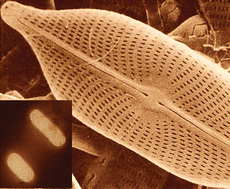Freshly prepared acid-cleaned biosilica of 21 different diatom species was studied using a combination of wide, small, and ultrasmall angle X-ray scattering analysis (WAXS, SAXS, and USAXS) in order to determine whether the structural and fractal properties from the subnanometer level up to dimensions of several microns are species-specific, and if so to quantify them. WAXS data are in line with the amorphous nature of this kind of biosilica: no Bragg reflections were observed at the level below 1 nm. Straight domains in the scattering spectra (in both SAXS and USAXS) revealed the presence of different fractal regions with highly species-specific transition points, as part of the surface structure. All silica specimens had four of these fractal regions, but with a length scale per region characteristic for each specimen except for the region (Region I) covering the WAXS domain (d < 1.5 nm). In this first region no fractal behavior was observed for the amorphous biosilica. Region II, with a fractal dimension (Ds) over 3.8, which indicates a smooth surface, covered the lower SAXS domain (1.5 < d < 10 nm). Region III (3.3 < Ds < 3.8), in the upper SAXS and lower USAXS domain (10 < d < 396 nm), represented a rougher surface, whereas Region IV (Ds < 2.8), the upper USAXS domain (d > 396 nm), revealed the roughest surface. Transition points between straight regions in the scattering spectra did relate to the dimension of meso- and macro-pores that are known to be present in diatom biosilica; the pore sizes determined from the spectra agreed with estimates made from electron micrographs. Interestingly, dominant scattering peaks were observed in USAXS, as if we were dealing with crystals as in highly ordered MCM-type silicas. This crystallinity was only apparent, not real; it is most probably due to the high regularity in pore distributions in diatom biosilica in the size range of 100 to ∼500 nm. Our data show that diatom biosilica has quantifiable species-specific fractal surface properties, next to the well known species-specific pore architecture that is well beyond those of other well-ordered artificial silica materials. Consequently, it is likely that each also has its own surface pattern of reactive sites and in view of these large variations each diatom species potentially can be the source for the design of a different silica-based material.


 Please wait while we load your content...
Please wait while we load your content...